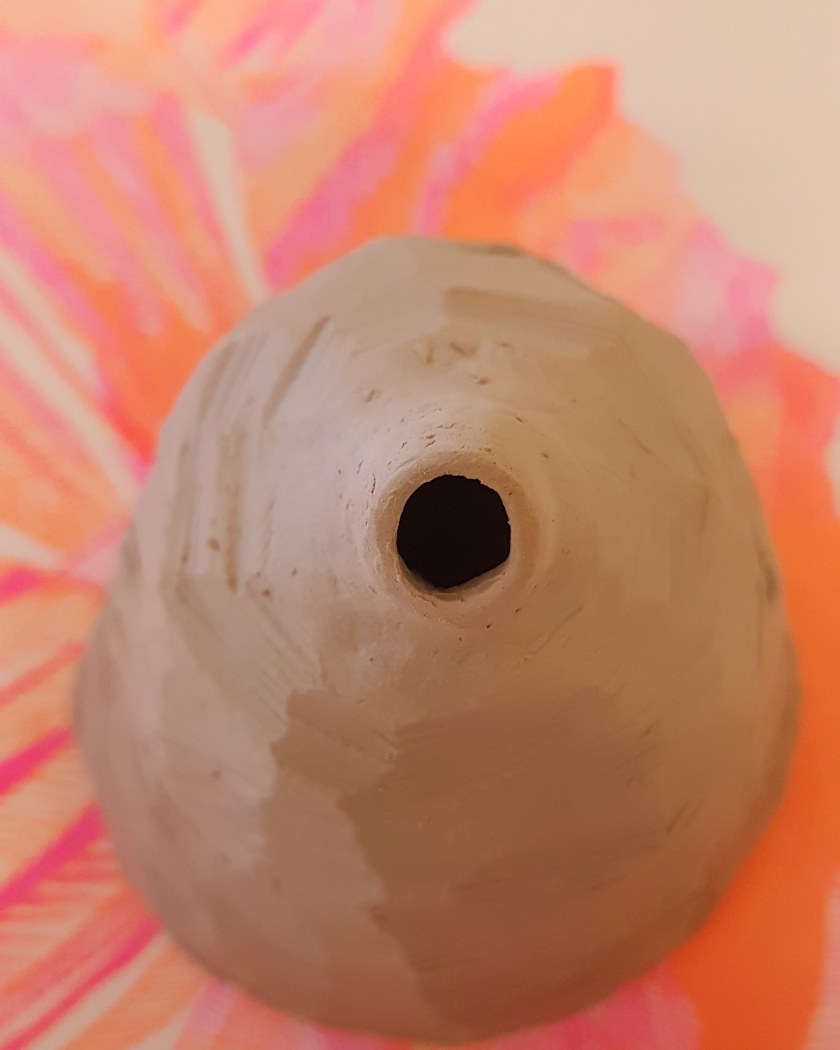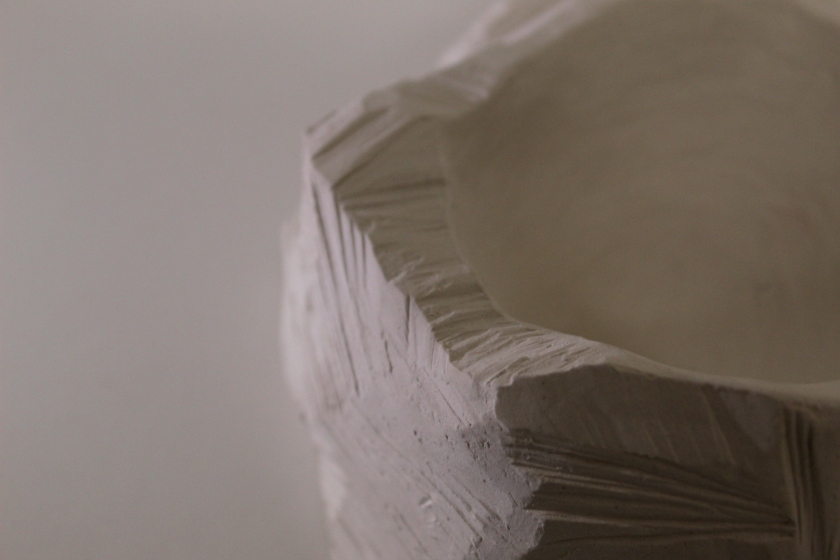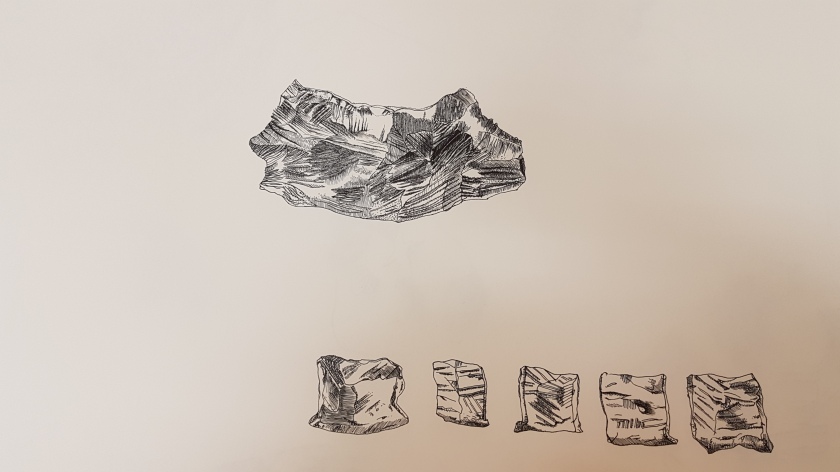Macro Photography Outcomes
First Observations
This sketch below is my first observational sketch of the broken ceramics.

Critical Analysis
The composition is very interesting, quite ambiguous. Lots of detail. Interesting to look at and piques curiosity. Demonstrative of skill although not demonstrating an ability to complete one form.
Moving on
Although I really like this sketch upon reflection I have realised that it isnt as eyecatching or instantly interesting, I would like for my outcomes to draw my audiences attention and then refer them to the inspiration.
This style of composition doesnt inform the viewer of what the subject is.
Exhibiting The 2nd Artifact
My intentions for displaying the 2nd artifact is for the sketches to be viewed by themselves. I decided to not show an object next to the sketches as I wanted the sketches to be seen as a work themselves. I am often aware that sketches are perceived to be lesser than other works and often are worth less than in a monetary value in comparison to made objects or paintings. With hindsight, I now feel that I should have displayed my bowl outcome or another of the ceramic pieces in front of the sketches so that the viewer would be able to make the connection between the 2D, complicated and faceted drawings and the 3D object that the sketches are observing. I feel that the work without the 3D object is an interesting trio of sketches and can be appreciated for their detail but the lack of the object makes them just interesting. If I had included the objects then the viewer would have understood the textural relationship between the two.
I hung the sketches up by fishing wire and re-painted the wall white in my efforts to display my work in the context of where it would be seen. My work is made with the intentions of exhibiting it in a gallery/exhibition space, it is intended to be viewed as and next to art. My efforts of displaying professionally have been successful up to a point. The clean white wall and the transparent thread has been effective in showing professionalism but the way that the paper hangs, showing shadow behind the sketches distracts my eyes away from the work itself. Also using coloured clips to hold the paper is also distracting, but they do hint to my use of colour and the personality and style that is incorporated in my way of working. With hindsight I would have considered my methods of displaying further, next time I intend to dedicate an allotted amount of time to consider display and what materials and equipment I will use.
Below is an image of my installed work exhibited in the studio space, my work consists of a trio of observational textural drawings hung on the wall. The plaster sculpture next to my sketches is my peer Amy Evans’ work.

Process: Observing new forms
As I have been working with the process of conversing between 2D and 3D, making and observing, I have ended up with many sketches. Although these sketches below are not my second artifact their importance to my research and back up work is vital. These sketches show that I was more focused over texture rather than form. Although I really enjoy the forms that I have made I have not hinted to that in my second artifact. In these sketches I show both form and surface texture, but the form is made of a simple line drawing whereas the texture is shown as detailed and sporadic yet composed.
I want to show these images away from the other sketches in order for them to be viewed in a different light. They are important to my backup work for this project in showing how I started observing both form and texture before eliminating form and focusing and abstracting on the texture. My purpose for showing these separate is to appreciate my development of composition and showing my capabilities that have recently been developed in my skill set. I believe that this work backs up my developing skill or sketching and self-developed style.


New form
I have been playing with new forms and I ended up developing this shape which features a tiny opening slightly facing horizontal instead of vertical. I really like this feature as it isn’t conventional or necessarily functional. Beyond this project I really want to continue playing with this form.
To document this piece I placed it on top of a pink and orange sketch in order to tie in the relationship between the form and observation. My intention was to visually show the back and forth process I have been using, the conversation between 2D and 3D.


Technique: Photography
After re-visiting the photo’s I took I saw with new eyes these images. I really like these images as I feel they aren’t just documentation or observational but they have a feeling to them like a drawing has, they have a style which I feel is reflected in my sketches. I really enjoy these images and I hope to develop this style further.



Process: Sketching Surface Texture
After my initial sketches responding to the mortar I made ceramic forms also with a similar surface texture. In response to those made items I wanted to sketch their texture but to help myself to see and re-visualise their pattern on paper using colour. I wanted to experiment and use bright colours only to help my eyes see the texture for the first time. This difference in colour was challenging as I had to re-think my documentation of the texture and page layout as these colours are seen differently to black ink on white paper. Using the orange and pink pushed me to challenge my sketching skills, I had to re-think my presentation of the texture. This experiment was really beneficial to the project as it helped me develop the style that I would use in the final artifacts.
Orange and Pink

After forming this sketch I reflected and doing so I decided to maintain this style but switch back to the fine liner as my tool for mark making. I enjoy the detail that I can put in with the fine liner and using that I can play with the perception of the pattern. The fine lines help challenge surfaces and platforms that I was sketching. I personally think that the fine lines and my use of them effects the paper and the sketch as a whole on a dimensional level. Although I feel that the sketches are effective I do see all their faults, I see where my sketching skills are lacking and although I did practice and really try to develop them I need to work on them so that I develop my skills further. I intend to research into effective sketching skills to challenge perceptions of depth and angles.


The Ceramic Texture
Here are same close up shots of the ceramic mortar that I made. At this stage the mortar has been bisque fired, I wanted to capture the texture of the piece before I glazed it as I am weary that the glaze will mask the sharpness of some of the edges and blur the others into each other.
Although I am feeling more confident with photography I realised after viewing the images I took that I need to work on making sure the image is fully focused. Here are a few images that I feel display the surface texture efficiently.









Process: Sketching the Mortar
I’ve always thought of myself as a sketcher as this process really helps me make connections between objects/things and ideas. I wanted to sketch the successful mortar as it would help me get to know it. I really wanted to experience the mortar and really connect with the surface texture. As a warm up I decided to sketch the test tiles I had made by pressing clay into the surface texture of the mortar. I did this to mimic the mortar but I was aware that they would have the reverse texture of the mortar.
Starting with the test tiles helped me loosen up my arm and hand and helped me to really focus and see what I was sketching. As each tile was a different shape and size I really wanted to emphasise their differences without exaggerating. With each tile I felt myself improving, I was getting more detail in a less clumsy way. Catching the shadows falling on the tiles made me adapt my style, I had never really done such detailed drawing before. I really enjoyed the process of this drawing as I learned that I could sketch in this new way and capture textural details.
The difference in my sketching is visible from the test tiles to the mortar. The test tiles show the depth and give the forms a 3D shape. In comparison, the mortar has a flat appearance and although it suggest a 3D shape with the its angles it has no depth to it. This was not my intention but during sketching I felt exhausted by the amount of detailing I was doing and I thought that giving the shape a 3D likeness would compromise the quality of the drawing. If the mortar was drawn is wholeness then in my opinion the detailing would be compromised, the sketch would be too busy. Although I was not intending for the drawing to be presented as a piece but I wanted to start with this mindset in my sketches, to be aware of composition and complexity so that I could design and sketch a balanced drawing. This sketch has not filled the paper and this was not in my intentions to do so as it was an experimental observation but with further explorations I would consider the size of the paper I would use and the scale of the sketch.








